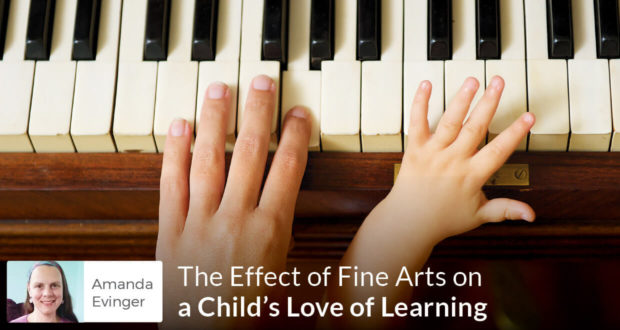Summary
Amanda Evinger shares research and personal experience to show the impact and genuine love of learning that the fine arts can add to a child’s education.We’ve all encountered someone, at some point in our lives, who used the fine arts as a way to express himself, find his niche in life, or flourish academically.
We may even have a child or a spouse who is an artist, or we may be artists ourselves. The fine arts may seem like a wonderful way to connect with our children, or perhaps we find them to be a stumbling block. When it comes to homeschooling, we might become frustrated with artistically-minded children, especially if we don’t happen to be artistically inclined ourselves.
With worksheets and tests to complete and SAT’s looming in the future, their absorption with painting portraits (of us, when we haven’t combed our hair), writing poetry in their tree house (when the dog should be taken for a walk), or begging their siblings to act in their latest play may concern us — even deeply. Will they “make it” in this world when they act so dreamy, are dramatic about everything, and struggle with basic math?
The good news, Dads and Moms, is that studies reveal time and time again the tremendous importance that fine arts do play in the education and formation of a child. So we can relax a little, make sure William gets his chores and basic school work done, and then allow him the freedom to pursue the unique, powerful artistic talents that the Creator has graciously bestowed upon him. After all, isn’t this part of the beauty of homeschooling, with all of its flexibility and freedoms?
In 2002, the Arts Education Partnership produced a report which revealed that schoolchildren exposed to drama, music, and dance are often more proficient at reading, writing, and math.
The report looked at over 62 different studies from 100 researchers, spanning the range of fine arts from dance to the visual arts. Using this data, researchers determined that students who received more arts education did better on standardized tests, had more polished social skills, and were more motivated than those who had reduced or no access.
The study led them to believe that the fine arts could be a valuable asset for teaching students of all ages. An updated report was conducted by the same researcher in 2010, yielding similar findings.
Furthermore, another study, the 2006 Solomon R. Guggenheim Museum study (also featured on the website mentioned above) revealed the crucial link between arts education and improved literacy skills. It was the result of a pilot program which sent artists into schools to teach students and help them create their own masterpieces. As the website explains:
“Kids who took part in the program performed better on six different categories of literacy and critical thinking skills than those who did not. While students did better on an oral exam, they did not on standardized, written literacy tests — a disparity researchers said could exist because they did not emphasize written communication in the program.
Program organizers believe the improvements were the result of students learning valuable critical thinking skills while talking about art, which could then be applied to understanding and analyzing literary materials. Students could even take these skills further at online colleges for creative writing or broadcast journalism.”
Most importantly, the Church has some beautiful things to say about the importance of the fine arts, and the unique and powerful vocation of artists. In his Letter to Artists, Pope St. John Paul II writes:
“It is in living and acting that man establishes his relationship with being, with the truth and with the good. The artist has a special relationship to beauty. In a very true sense it can be said that beauty is the vocation bestowed on him by the Creator in the gift of “artistic talent”. And, certainly, this too is a talent which ought to be made to bear fruit, in keeping with the sense of the Gospel parable of the talents (cf. Mt 25:14-30)… Those who perceive in themselves this kind of divine spark which is the artistic vocation—as poet, writer, sculptor, architect, musician, actor and so on—feel at the same time the obligation not to waste this talent but to develop it, in order to put it at the service of their neighbor and of humanity as a whole.”
Throughout the letter, St. John Paul II continues to express the critical place that beauty has in lifting the human heart to the Creator in praise of His goodness.
“In this sense it has been said with profound insight that ‘beauty will save the world’. Beauty is a key to the mystery and a call to transcendence. It is an invitation to savor life and to dream of the future. That is why the beauty of created things can never fully satisfy. It stirs that hidden nostalgia for God which a lover of beauty like Saint Augustine could express in incomparable terms: ‘Late have I loved you, beauty so old and so new: late have I loved you!’”
As homeschooling parents, we are blessed and challenged with the privilege of sharing this “beauty” with our children as often as we can. The fine arts, when practiced in accord with basic Christian morals, are ideal for reaching the hearts of our children in a way that nothing else can.
Thankfully, Seton has some incredible art texts which strive to bring children this beauty, and teach them how to create it themselves. There are also a rich variety of homeschooling resources out there which can fill our homeschools with beauty and joy. Recently, I bought a set of 100 art cards (off of Amazon.com) which depict the great works displayed in the Vatican Art Museum – I can’t wait until they arrive in the mail! My children also really enjoy studying many of the Mommy, It’s a Renoir art cards, as well as good, wholesome children’s art dictionaries (such as Usborne’s Lift the Flap Art Book for Children).
We also keep a great stash of art supplies and craft materials around the house, as well as some play scripts designed for Christian children (such as the ones written by Mother Mary of Loyola) and plenty of music CDs. I am truly grateful for all of the rich blessings of creativity that these materials bring into our home.
They help us embrace a genuine love of learning and bring beauty to each school day.
St. Catherine of Bologna, Patron Saint of the Fine Arts, pray for us!

 Seton Magazine Catholic Homeschool Articles, Advice & Resources
Seton Magazine Catholic Homeschool Articles, Advice & Resources

